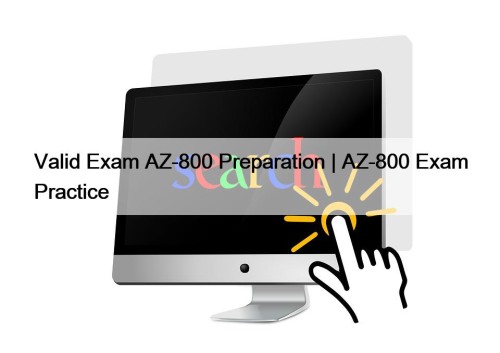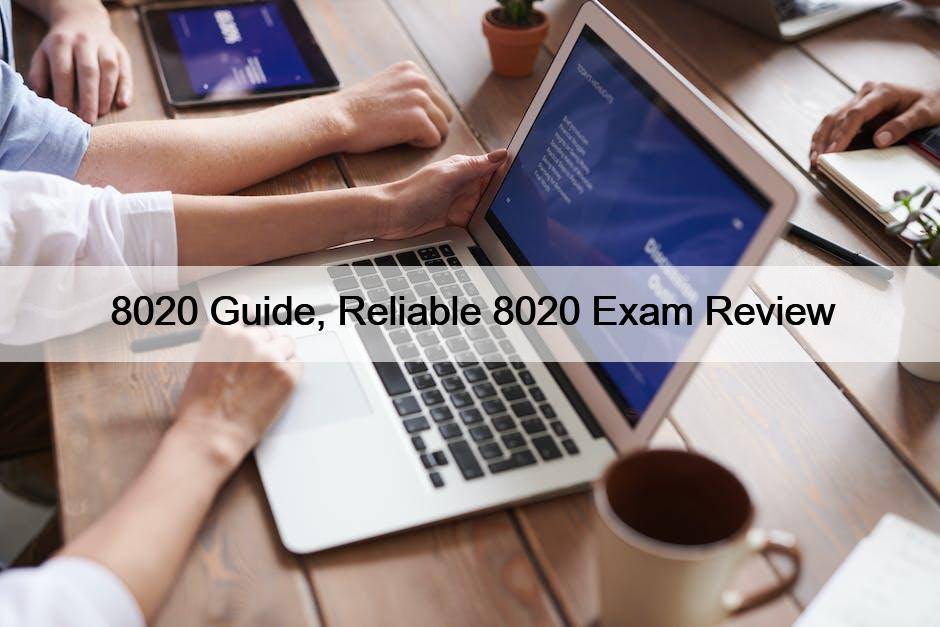Most Popular
 Professional Valid A00-231 Exam Syllabus & Leader in Certification Exams Materials & Trustworthy New A00-231 Test Experience
Professional Valid A00-231 Exam Syllabus & Leader in Certification Exams Materials & Trustworthy New A00-231 Test Experience
DOWNLOAD the newest Pass4sures A00-231 PDF dumps from Cloud Storage ...
 Valid Exam AZ-800 Preparation | AZ-800 Exam Practice
Valid Exam AZ-800 Preparation | AZ-800 Exam Practice
2025 Latest Lead1Pass AZ-800 PDF Dumps and AZ-800 Exam Engine ...
 D-PST-MN-A-24 Test Dumps.zip, Latest D-PST-MN-A-24 Test Questions
D-PST-MN-A-24 Test Dumps.zip, Latest D-PST-MN-A-24 Test Questions
2025 Latest Pass4cram D-PST-MN-A-24 PDF Dumps and D-PST-MN-A-24 Exam Engine ...



8020 Guide, Reliable 8020 Exam Review

What is more, we have free demos are freebies for your information. In case you are tentative about their quality, we give these demos form which you could get the brief outline and questions closely related with the 8020 practice materials. Only by practising them on a regular base, you will see clear progress happened on you. Besides, rather than waiting for the gain of our 8020 practice materials, you can download them immediately after paying for it, so just begin your journey toward success now.
Our PRMIA 8020 free demo provides you with the free renewal in one year so that you can keep track of the latest points happening in the world. As the questions of our PRMIA 8020 Exam Dumps are involved with heated issues and customers who prepare for the PRMIA 8020 exams must haven't enough time to keep trace of 8020 exams all day long.
ORM Certificate - 2023 Update study guide: exam 8020 real vce collection
Free demo is available for 8020 exam bootcamp, so that you can have a deeper understanding of what you are going to buy. In addition, 8020 exam dumps are high quality and accuracy, since we have professional technicians to examine the update every day. You can enjoy free update for 365 days after purchasing, and the update version for 8020 Exam Dumps will be sent to your email automatically. In order to build up your confidence for the exam, we are pass guarantee and money back guarantee for 8020 training materials, if you fail to pass the exam, we will give you full refund.
PRMIA 8020 Exam Syllabus Topics:
| Topic | Details |
|---|---|
| Topic 1 |
|
| Topic 2 |
|
| Topic 3 |
|
| Topic 4 |
|
| Topic 5 |
|
| Topic 6 |
|
| Topic 7 |
|
PRMIA ORM Certificate - 2023 Update Sample Questions (Q14-Q19):
NEW QUESTION # 14
For the WorldCom case, what was one of the causes of the failure?
- A. The lack of a CRO during the final IPO.
- B. A rapid pace of acquisitions and poor integration of acquired companies.
- C. Risk models that did not reflect loosened underwriting standards of mortgage originators.
- D. Unauthorized trading in derivatives.
Answer: B
Explanation:
Step 1: Understanding the WorldCom Case
WorldCom was one of the largest U.S. telecom companies before its collapse in 2002 due to fraudulent accounting practices and poor risk management.
The company expanded aggressively through acquisitions but failed to integrate them properly, leading to financial mismanagement and accounting fraud.
Step 2: Why Option C is Correct
WorldCom acquired over 60 companies in a short period without proper integration.
This masked financial problems and led to $11 billion in fraudulent accounting adjustments.
PRMIA and risk management frameworks stress that poor integration after rapid acquisitions increases operational and financial risks.
Step 3: Why the Other Options Are Incorrect
Option A ("Risk models and mortgage underwriting") → Incorrect because this describes the 2008 financial crisis, not WorldCom.
Option B ("Lack of a CRO during IPO") → Incorrect because WorldCom was well-established before its fraud-CRO absence was not the main issue.
Option D ("Unauthorized derivatives trading") → Incorrect because WorldCom's failure was due to fraudulent accounting, not derivatives.
PRMIA Risk Reference Used:
PRMIA Corporate Governance Guidelines - Discusses risks of poor post-merger integration.
SEC Investigation on WorldCom (2002) - Identified fraudulent accounting due to failed acquisitions.
NEW QUESTION # 15
What are some of the properties of Bottom-Up KRIs?
- A. Selected by local management, based on key controls or weaknesses identified by audit reports, reported on quarterly.
- B. Seated by senior management: tied to internal loss events at the legal entity, country, business and / or product level, reported.
daily, weekly or monthly. - C. Are not used due to changes in regulations.
- D. Selected by local management: tied to internal loss events at the legal entity, country, business and / or product level, reported daily, weekly or monthly.
Answer: D
Explanation:
Definition of Bottom-Up KRIs
Bottom-Up Key Risk Indicators (KRIs) are identified at the operational level, focusing on localized risks within business units.
They are tied to actual internal loss events and reported frequently (daily, weekly, or monthly) to capture ongoing trends.
Key Properties of Bottom-Up KRIs
Selected by local management → Ensures relevance to specific business areas.
Tied to internal loss events → Helps in tracking risk patterns within specific legal entities, countries, or business units.
Reported frequently → Allows for timely risk detection and mitigation.
Why Answer D is Correct
Bottom-up KRIs focus on localized risk exposure and are monitored frequently to track operational changes.
Why Other Answers Are Incorrect
Option
Explanation:
A . Seated by senior management: tied to internal loss events at the legal entity, country, business, and/or product level, reported daily, weekly, or monthly.
Incorrect - Senior management sets top-down KRIs, while bottom-up KRIs are managed locally.
B . Selected by local management, based on key controls or weaknesses identified by audit reports, reported quarterly.
Incorrect - While audit reports are useful, bottom-up KRIs are based on loss events, not just audit findings. Quarterly reporting is too infrequent.
C . Are not used due to changes in regulations.
Incorrect - Bottom-up KRIs remain essential despite regulatory changes.
PRMIA Reference for Verification
PRMIA Risk Indicator Best Practices
Basel Committee's Risk Measurement and Reporting Guidelines
NEW QUESTION # 16
In operational resilience, what is impact tolerance?
- A. Impact tolerance is a firm's risk capacity statement.
- B. Impact tolerance is a firm's tolerance for disruption to a particular business process.
- C. Impact tolerance is a firm's tolerance for disruption to a particular business service.
- D. Impact tolerance is a firm's risk appetite statement.
Answer: C
NEW QUESTION # 17
Risk Capacity for a bank is defined as the:
- A. Amount of risk the regulator sets for the bank.
- B. Amount of risk the bank wishes to take.
- C. Ability to withstand an extreme event and make a profit.
- D. Ability to suffer an extreme event with an orderly wind up with only shareholders losing money.
Answer: D
Explanation:
Step 1: Definition of Risk Capacity
Risk Capacity refers to the maximum level of risk a bank can absorb while still maintaining orderly operations or, in extreme cases, conducting an orderly resolution.
PRMIA and Basel III define risk capacity as a bank's ability to absorb losses in a crisis without systemic consequences.
Step 2: Why Option D Is Correct
The ultimate test of a bank's risk capacity is whether it can survive an extreme shock without harming depositors or financial markets.
Regulators ensure that a bank can be wound up in an orderly manner so that only shareholders lose money, while depositors and creditors remain protected under resolution planning frameworks.
Step 3: Why the Other Options Are Incorrect
Option A ("Amount of risk the bank wishes to take")
Incorrect because this describes Risk Appetite, not Risk Capacity.
Option B ("Amount of risk the regulator sets for the bank")
Incorrect because regulators set capital requirements, but the bank's actual risk capacity is based on its own capital structure and business model.
Option C ("Ability to withstand an extreme event and make a profit")
Incorrect because risk capacity is about survival, not profit-making during extreme events.
PRMIA Risk Reference Used:
Basel III Risk Capacity Standards - Defines the ability to absorb losses during crises.
PRMIA Risk Governance Framework - Describes how banks should manage risk capacity through capital buffers.
Final Conclusion:
Banks must be able to withstand an extreme event and conduct an orderly wind-up if necessary, ensuring that only shareholders bear the loss, making Option D the correct answer.
NEW QUESTION # 18
The Internal Loss Multiplier (ILM) is part of the Basel III Standardized Approach. Which of these definitions best descibes it?
- A. t is a scaling factor that is based on a bank's average historical losses.
- B. It is a non-financial factor that is based on a bank's average historical losses.
- C. It is uniform, and is used for indicating consistent incidents on an average return basis.
- D. It is a financial-statement-based proxy for operational risk.
Answer: A
Explanation:
The Internal Loss Multiplier (ILM) is a key component of the Basel III Standardized Approach for Operational Risk. It is designed to adjust capital requirements based on a bank's historical loss experience.
Definition of ILM
ILM is a scaling factor that adjusts the operational risk capital requirement based on a bank's internal loss history.
It is derived using a formula that incorporates historical operational risk losses relative to a bank's revenue.
Why ILM Exists in Basel III
Basel III replaced the Advanced Measurement Approach (AMA) with a Standardized Approach that includes ILM to ensure that banks with high historical losses hold more capital for operational risk.
Why Other Answers Are Incorrect
Option
Explanation:
A . It is a financial-statement-based proxy for operational risk.
Incorrect - ILM is not a general financial statement proxy; it specifically adjusts capital based on past operational losses.
B . It is a non-financial factor that is based on a bank's average historical losses.
Incorrect - ILM is financial in nature because it directly influences capital requirements.
D . It is uniform, and is used for indicating consistent incidents on an average return basis.
Incorrect - ILM is not uniform; it is bank-specific and varies based on loss history.
PRMIA Reference for Verification
PRMIA Operational Risk Standards
Basel III Standardized Approach for Operational Risk
NEW QUESTION # 19
......
In the present market you are hard to buy the valid study materials which are used to prepare the 8020 certification like our 8020 latest question. Both for the popularity in the domestic and the international market and for the quality itself, other kinds of study materials are incomparable with our 8020 Test Guide and far inferior to them. Our 8020 certification tool has their own fixed clients base in the domestic market and have an important share in the international market to attract more and more foreign clients.
Reliable 8020 Exam Review: https://www.certkingdompdf.com/8020-latest-certkingdom-dumps.html
- 8020 Valid Practice Questions 👮 8020 Latest Exam Guide 🧪 Exam 8020 Price 🌕 Immediately open ▛ www.dumpsquestion.com ▟ and search for 【 8020 】 to obtain a free download 👆8020 Exam Questions Pdf
- Quiz PRMIA - Newest 8020 Guide 🍱 Search for ☀ 8020 ️☀️ and download it for free on [ www.pdfvce.com ] website 🚡8020 Test Braindumps
- Top 8020 Guide - The Best Site www.pdfdumps.com to help you pass 8020: ORM Certificate - 2023 Update 🍏 Search for ▶ 8020 ◀ and download it for free immediately on ⮆ www.pdfdumps.com ⮄ 🚮8020 Valid Practice Questions
- 8020 Testking Cram - 8020 Vce Torrent - 8020 Prep Pdf 🍫 Copy URL 《 www.pdfvce.com 》 open and search for ▶ 8020 ◀ to download for free 😺8020 Reliable Learning Materials
- NEW PRMIA 8020 DUMPS (PDF) AVAILABLE FOR INSTANT DOWNLOAD [2025] 🧳 Open ⇛ www.actual4labs.com ⇚ and search for ( 8020 ) to download exam materials for free 😌8020 Exam Collection Pdf
- 8020 Brain Dump Free 🥇 8020 Latest Test Camp 💞 8020 Valid Practice Questions 🏘 Search for ➤ 8020 ⮘ on ⇛ www.pdfvce.com ⇚ immediately to obtain a free download 🤞Valid 8020 Exam Syllabus
- 8020 Brain Dump Free 🚈 Certification 8020 Exam 🕵 Valid 8020 Exam Syllabus 🍛 Easily obtain ➡ 8020 ️⬅️ for free download through ⮆ www.examcollectionpass.com ⮄ 🎠8020 Reliable Learning Materials
- NEW PRMIA 8020 DUMPS (PDF) AVAILABLE FOR INSTANT DOWNLOAD [2025] ✈ ➥ www.pdfvce.com 🡄 is best website to obtain { 8020 } for free download 🍏8020 Reliable Learning Materials
- Top 8020 Guide - The Best Site www.vceengine.com to help you pass 8020: ORM Certificate - 2023 Update 🦹 Enter ⏩ www.vceengine.com ⏪ and search for ➡ 8020 ️⬅️ to download for free 🙍8020 Test Braindumps
- New Soft 8020 Simulations 🥓 8020 Brain Dump Free ☘ Certification 8020 Exam 🌙 Download ⏩ 8020 ⏪ for free by simply searching on ⏩ www.pdfvce.com ⏪ ⏯Certification 8020 Exam
- 8020 Test Braindumps 🐞 8020 Reliable Braindumps Ppt 🍬 Certification 8020 Exam 🍂 Search on ➥ www.prep4pass.com 🡄 for 【 8020 】 to obtain exam materials for free download 🐤8020 Valid Practice Questions
- 8020 Exam Questions
- skillgems.online afshaalam.com felbar.net me.sexualpurity.org venus-online-software-training.com palabrahcdi.com academy.techbizonline.com amanchopra.net yu856.com thehackerzone.in
Tags: 8020 Guide, Reliable 8020 Exam Review, Free 8020 Brain Dumps, 8020 Latest Test Camp, 8020 Review Guide